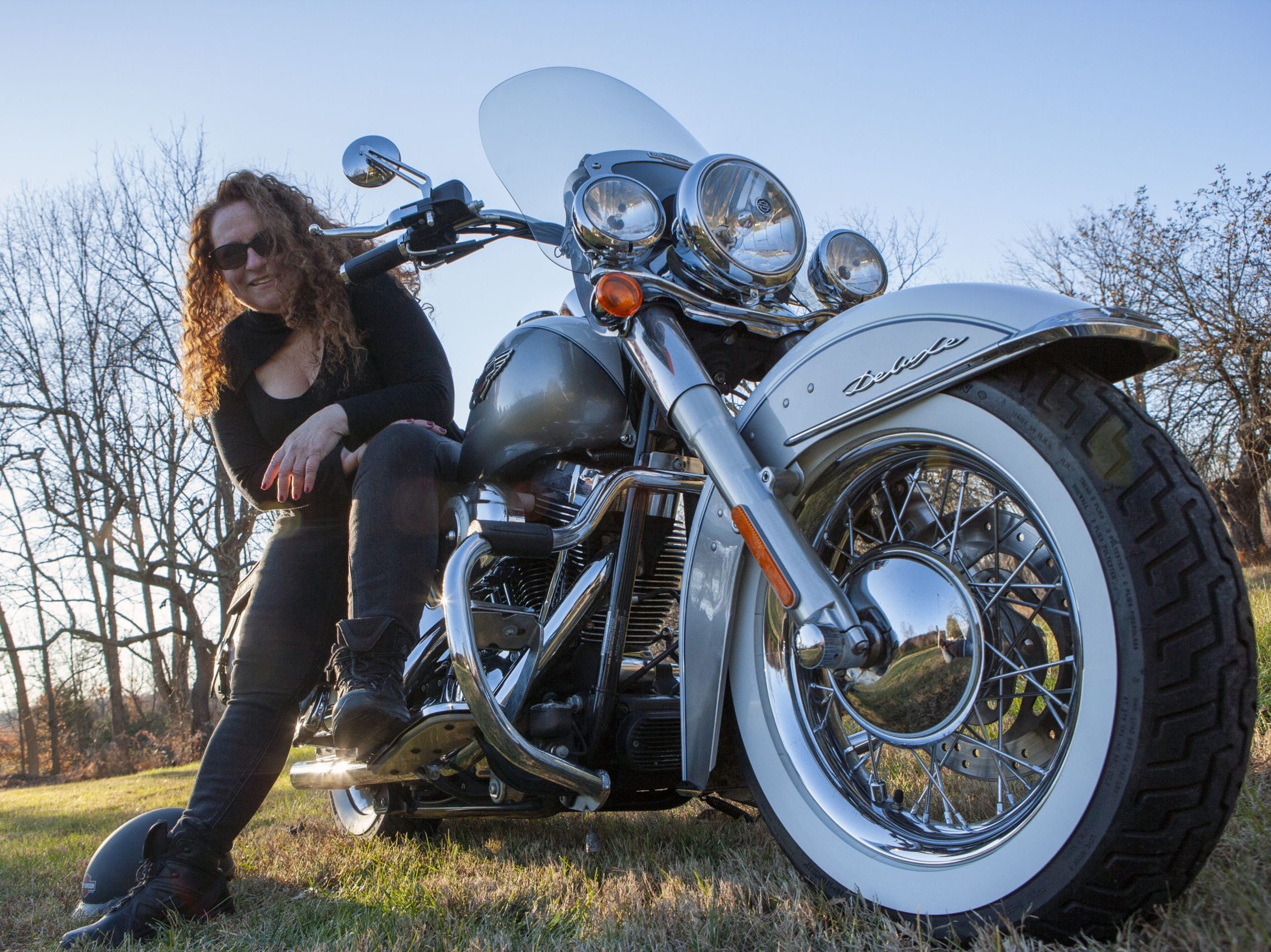
The road is the color of onyx, with accents of bright yellow and white along its sides and spine. As it curves along the steep shores of Lake Michigan, the uppermost branches of the neighboring trees form a quiet, shaded canopy riders call the “Tunnel of Trees.”
Then the thunder comes.
Lady Fred (her real name), 60, a Michigan native who has ridden Harley-Davidsons for decades, rumbles over the asphalt on her 2005 Heritage Softail Classic. She leans to make the first of 135 curves on this 22-mile road, a streak of defiant, two-toned blue flashing through this lakeshore painting.
During her many years on her bike, named Lobo, Fred has accumulated several accomplishments in her self-assigned role as an advocate for female motorcycle riders, such as organizing the largest peace sign made of motorcycles, founding Michigan’s first women’s motorcycle ride and serving as the U.S. ambassador for International Female Ride Day. Fred hopes to encourage other women to start riding their own motorcycles.
As of today, nearly one in five motorcyclists are women, and experts predict that ratio will continue to narrow. The most iconic brand in the motorcycle world is Harley-Davidson, which is also the leading motorcycle manufacturer in the U.S.
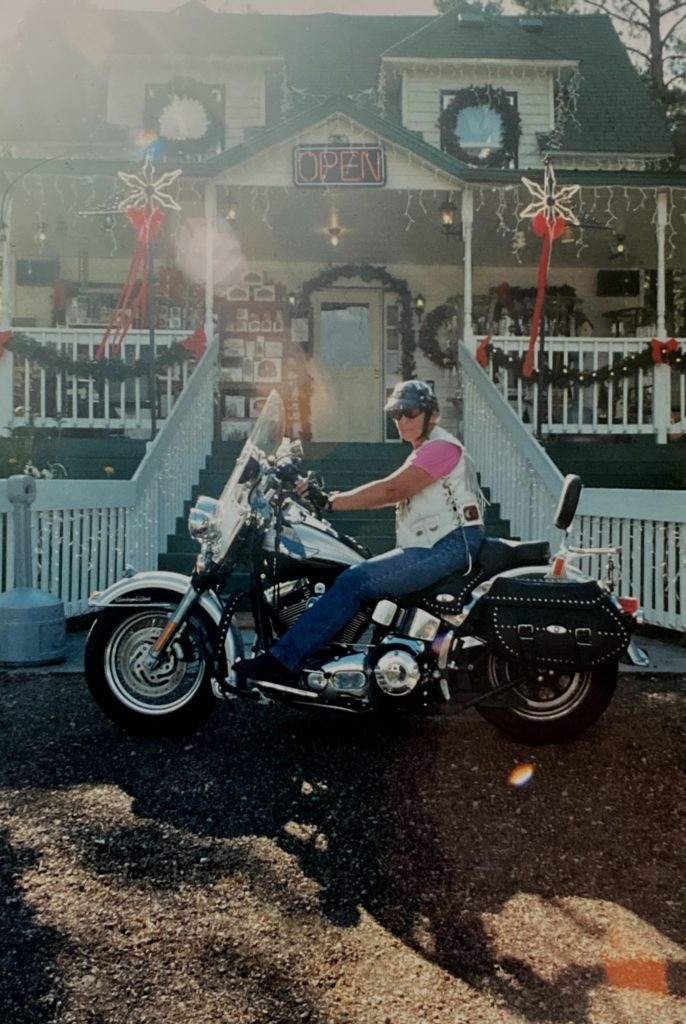
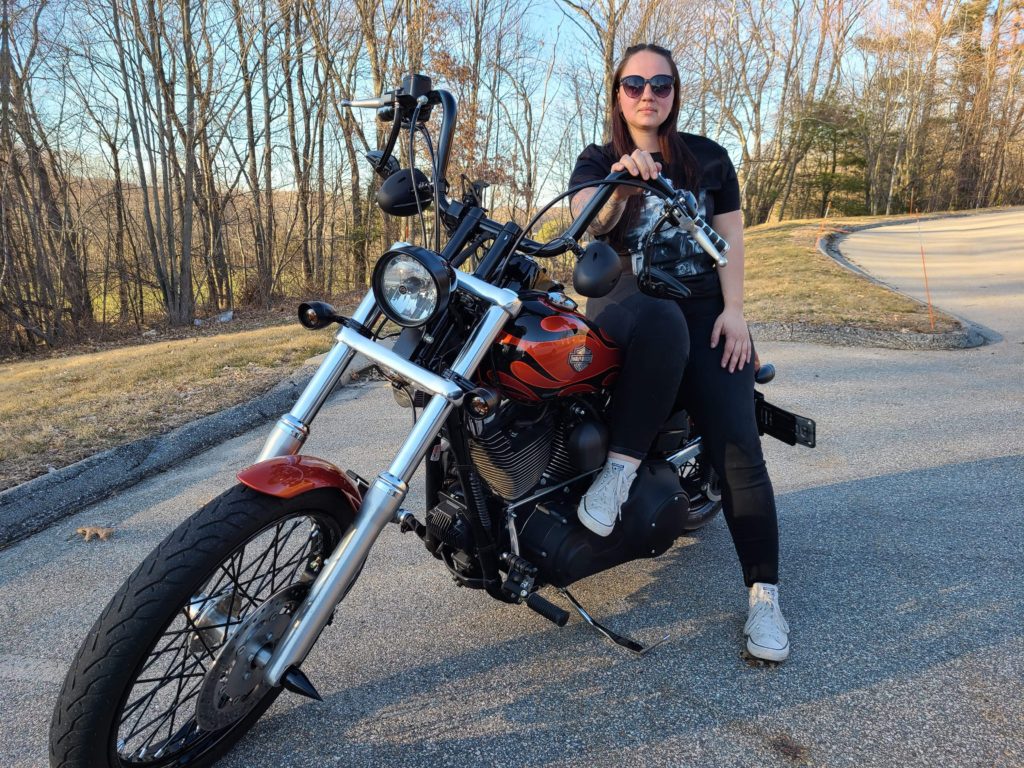
Left: Marian Colborn says she’s proud of launching a Women on Wheels (WOW) group. “Thirty of them in white vests, chaps, and patches on the back of the vests, all designed by us. My other fantastic time was a seven week trip across a lot of America: 10,300 miles, 41 rolls of film, 23 tunnels, 25 different states, six state capitals, four national monuments, unbelievably narrow, hairpin-turn roads — one heck of a trip!”
So, it stands to reason that as more women riders take to the road, many of them are riding Harley-Davidsons. In fact, about 12% of new H-D purchasers are women, according to Paul James, H-D’s public relations manager.
This raises the big question: What’s life like for the women who ride Harleys, bikes that many consider to be a symbol of freedom and masculinity?
Until a few decades ago, the answer to that question was lonely, according to another Michigan native named Marian Colborn, 81. Growing up, Colborn never thought she’d do much traveling. She was raised during the tail end of the Great Depression and can still remember the unique smell of government-issued cheese. Decades ago, she says, people were leery of bikers because of groups like the Hells Angels. Women were also still expected to be obedient housewives, so there weren’t many of them out on the road.
Despite all that, Colborn saddled up and began traveling in 1955, much to her mother’s dismay, visiting a total of 48 states during her 64 years of riding. After marrying, she even taught her now-late husband how to ride. She says she didn’t start seeing a significant number of female riders until the mid-1960s. Colborn currently owns a 2007 Heritage Softail Classic, but is now unable to ride because of her macular degeneration, an eye disease that causes deterioration of the retina.
Colborn has watched the tide slowly turn for women in the Harley-Davidson and motorcycle world, an experience that solidified her belief that riding is “not just for men anymore,” she said.
Although more women are transitioning from passenger or observer to rider, they still face the misogyny often found in many male-dominated activities.
For example, take Brooke Levy, 27, a hydraulics mechanic in the Connecticut Air National Guard. She bought a 2011 Dyna Wide Glide two years ago when she started riding. Soon after acquiring the bike, Levy noticed an issue with its turnsignal. She took it to her local Harley-Davidson dealership to be fixed and was treated like “a ditsy woman who doesn’t know anything,” Levy said. It took someone else’s intervention before her bike received the work it needed.
“I was explaining it to the service guy, and he wouldn’t take my word for it until my boyfriend came over and repeated the same exact thing I had said, then the guy believed it,” Levy said. While many women no longer face blatant discrimination for riding motorcycles, they do have to endure the misperception of being uninformed and ignorant of the machines they are riding.
Luckily, there are men in the Harley-Davidson community who are allies for women riders. These men often advocate for and encourage the women in their lives to start riding. One of these men is Paul Anderson, 63, from Seneca, South Carolina. Anderson has encouraged his wife, daughter, and sister to take up riding. Between them, they now own five Harley-Davidsons. While he does worry about his daughter when she rides by herself, he still thinks it’s more fun to have his family members riding along in formation on their own bikes rather than on his back seat.
“I imagine there are quite a few women out there thinking, ‘Oh, I couldn’t learn to ride a motorcycle,’” Anderson said. “Sure, you can, especially when you see some of those demonstrations where a young woman is maneuvering a Harley as good as any man ever thought about riding the bike.”
Self-doubt is only one of many factors that could keep women from riding, female motorcyclists say. Of them, the two most prominent are the inherent dangers of being on a motorcycle and the stigma they often face from friends and family.
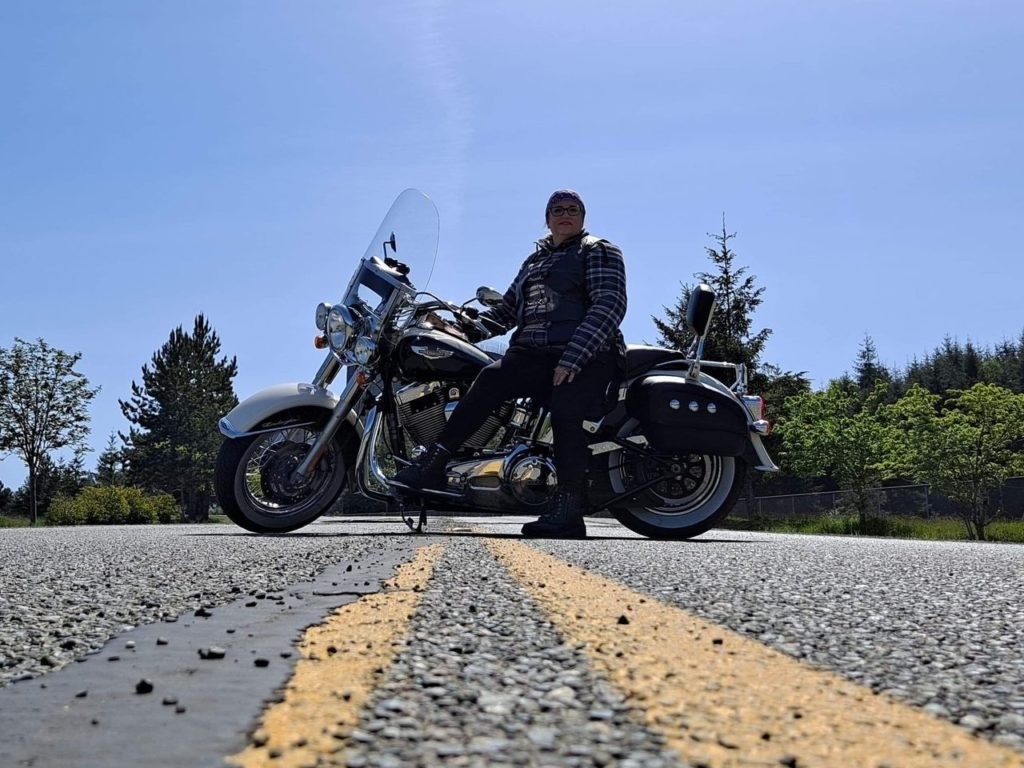
Susan Fenwick, 52, from Kingston, Washington, struggled with both of these issues. For most of her life, Fenwick was strongly against motorcycles, primarily because of her limited exposure to them and the perceived culture around them.
“I feared them because I had only been exposed to the stereotypical Harley rider with the big beard, long hair, chains, and skull and crossbones tattoos who drank a lot of alcohol and beat people up,” she related. “Then, when I got to my early 20s, I only really heard about them on the news when someone was killed in an accident. In my early 30s, I lost an acquaintance who was killed on a motorcycle. In my mind they were dangerous and only bad people rode them.”
Eventually, in October 2017— after her husband, stepchildren, and son began riding — Fenwick and her daughter gave in and jumped on the motorcycle bandwagon. About a year after making that decision, Fenwick bought a 2012 Softail Deluxe. Unfortunately, Fenwick says, she experienced judgment from her friends and family, who assumed she was going through a midlife crisis. Fenwick’s sister even begged her not to buy that first bike, claiming that she couldn’t stand the thought of her sister and best friend dying on the road.
“[My sister] is an emergency and urgent care doctor, so she sees firsthand what can happen to someone in a motorcycle crash,” Fenwick said. “Even for the first year she would get mad at me if I brought it up in front of her.”
Eventually, everyone accepted Fenwick’s decision, and now she only has one regret: that she didn’t start riding sooner.
Fenwick is also engaged with the Harley-Davidson community, which includes a multitude of organizations. One example is the Harley Owners Group (HOG), a sponsored international club for brand enthusiasts that has regional chapters connected to Harley-Davidson dealerships around the world.
Bridget Kellogg, 66, from New Milford, Connecticut, is one of two road captains for her local HOG chapter affiliated with the dealership in Danbury. Some HOG chapters, like Kellogg’s, also have a Ladies of Harley (LOH) subchapter. Kellogg will soon become the leader of her chapter’s LOH, who call themselves The Chrome Divas. Kellogg’s chapter organizes regular weekend rides and strives to provide riders with valuable friends and mentors within the Harley-Davidson community.
“I have never met such sincere, kind, and helpful women as those who ride,” Kellogg stated. “It’s everything I have heard it is, and I’ve never looked back.”
Women who ride motorcycles cherish this sisterhood and care deeply for those who never got the chance to ride, as Lisa Lewis, 48, a Cleveland native who rides a pink-and-silver Road Glide, knows all too well. She was asked to gather a group of female riders for the funeral service of 9-year-old Saniyah Nicholson, a fan of women riders who was killed during a drive-by shooting on the east side of Cleveland in 2018.
“[Saniyah’s] mom reached out to us and asked me to get a group of girls with pink motorcycles to lead her daughter’s hearse off to the cemetery,” Lewis said. “It was a sad moment, but it was cool to know that we could make Saniyah’s homegoing what her mom wanted and what she loved.”
While Kellogg does value this camaraderie and has a strong affection for her HOG and LOH chapter, she says there is one thing that Harley-Davidson could improve upon: the production of bikes that are initially suited to the company’s female fan base.
“There are ladies who are still questioning ‘Can I ride a Harley? Will it fit me?’” Kellogg said. “You can make all the modifications you want, but then you’ve got another $5,000 into the bike just to start. I don’t even know where [H-D] would begin with that, except that catering to the female market is something that I think they’re missing.”
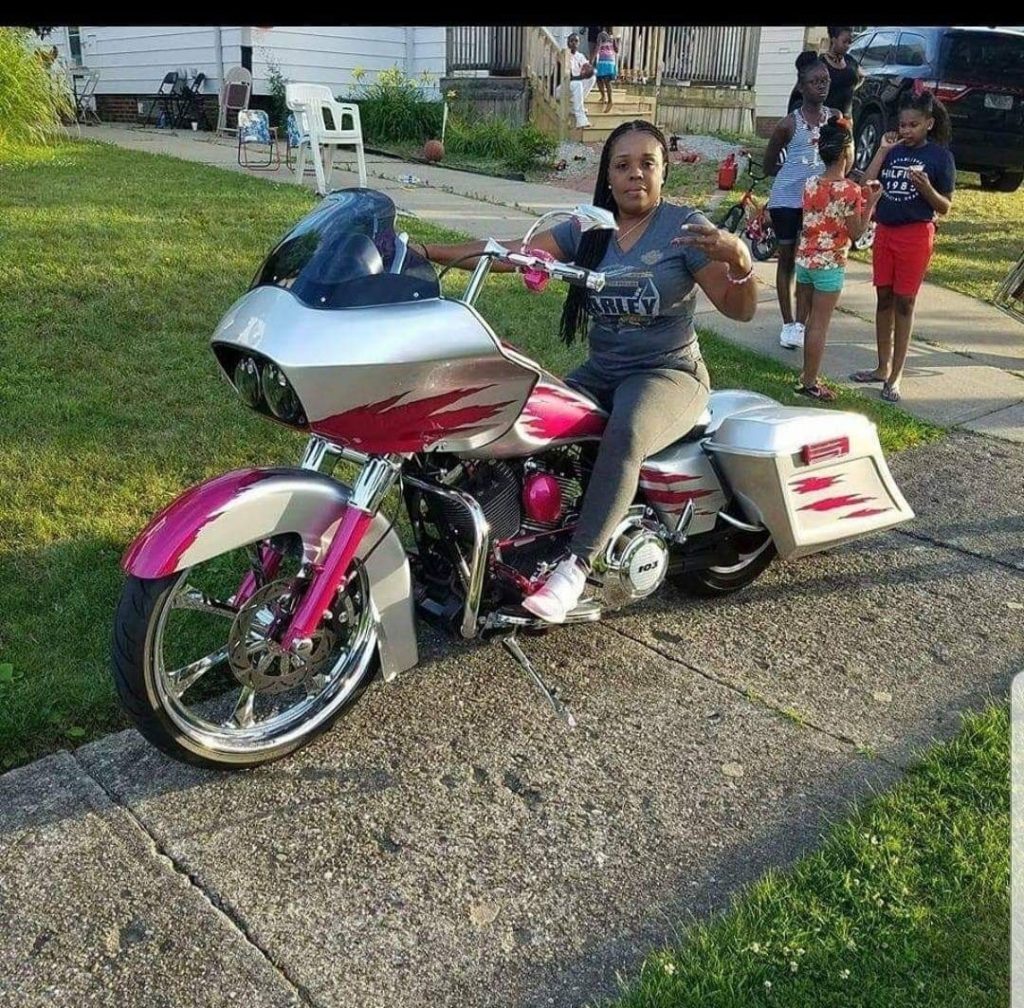

Some female riders might argue that Harley-Davidson has attempted to do this but received backlash from women riders. Pam Ross, 67, who rides a 2020 CVO Tri-Glide trike, witnessed a similar initiative backfire when she went to a Harley-Davidson training program in Orlando, Florida, a little over 10 years ago.
“The corporate guys on stage were introducing a new Sportster designed for women,” Ross said. “Women started standing up and yelling out, ‘I ride an Ultra Classic, I ride a Road Glide, I ride a Fat Boy, and I ride a Softail!’ So, it didn’t go over very well.”
The key difference here may be that women don’t necessarily want a bike specifically made for them; they want Harley-Davidson to make their currently existing products accessible for women so that they can ride them off the lot like their male counterparts.
“A number of our motorcycles are specifically aimed at what’s called a shorter-inseam rider,” James said. “We’ve made lowered versions of some of our most popular bikes in order to better fit the needs of women and other shorter riders.”
One model that caters to those with shorter inseams is the Pan America, which has an accessory suspension system that automatically lowers the bike as it comes to a stop. For those who want a larger bike but still need a low seat height and compact rider triangle, James suggests the Sportster Iron 883, cruisers such as the Softail Slim, and even touring bikes like the Street Glide.
Accessibility has also been an issue for BevJean Charles, an active member of the deaf riding community and a board member of the Deaf Bikers of America Foundation. Most deaf bikers ride with their local HOG chapters, though that usually means there’s only one deaf person in each chapter and no certified interpreters for monthly meetings. Although the members of Charles’ HOG chapter have done their best to keep her up to date on events and rides, she says she wished that Harley-Davidson made it easier for chapter leaders to get reimbursed for hiring certified interpreters.
“It’s very frustrating,” Charles stated in a Facebook message. “It makes it hard for deaf bikers to understand what’s going on or what they plan to do for a ride.”
Charles is following in the footsteps of her father, “Deaf Bikerdad,” who won trophies at several rallies with a Sportster he bought in the 1950s, by winning Best Sportster with her 1200 Custom in a couple of bike shows.
“They had no idea that a deaf woman motorcyclist owned it until I came to pick it up. I was high on cloud nine holding the trophy.”


There are many aspects of Harley-Davidson that keep women riding: the freedom, the camaraderie, the scenery, or, for Susie Thomas, 46, the mental health benefits and stress relief.
Thomas lives in Queensland, Australia, and has been riding Harleys for almost four years. She is also a member of two all-female riding groups. The first is named East Coast Female Riders (ECFR), and the second is one of ECFR’s subchapters, which focuses on the areas of Gladstone and Rockhampton. Although she now lives on the opposite side of the continent, Thomas’ favorite place to ride is Western Australia, which is where she grew up.
“Within an hour you could leave from the coast where you ride along the white sands, blue oceans, and then ‘go bush,’ inland,” Thomas said. “It’s absolutely beautiful, gorgeous country towns and roads, lots of places to go and so many variations to get there.”
While Harley-Davidson and the community it has fostered work on being more inclusive, women are continuing to inspire the next generation to start riding. Levy sees her impact at gas stations, where little girls point to her bike with clear delight on their ice-cream-covered faces.
Inspiring other women to ride is the reason Fred gave her mother for continuing to ride, even after she herself recovered from an accident in 2001.
“I have too many women depending on me,” Fred said. “If I didn’t ride again, what kind of message am I sending to them? I have to help many women learn how to ride. I am not going to let them down. I still have a lot of work to do to change the image of riding for women.”


